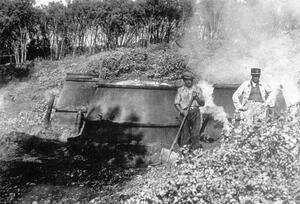Alarm and dread in the woods of Cadarache
Protected by a double electrical fence, patrolled night and day by armed Force Locale de Securite (FLS) agents, Cadarache is a very safe place. But it wasn't always so.
Up to the early 19th century, the mere mention of the name conjured alarm and dread: the woods, vast, deep and dark, were home to gangs of thieves and bandits who made a living ambushing and, more often than not, murdering the imprudent traveller who ventured into these parts with an inadequate escort. Under Count Raymond Beranger V, who ruled over Provence in the early 13th century, merchants were strictly forbidden to ride through the forest. But for many, there was no other choice: from Aix-en-Provence, only one road led to Rians, Vinon, and Greoux.
Violence peaked in the years following the Revolution. Convicts and galley slaves from nearby Toulon and Marseilles had been freed en masse, and hundreds of them had found shelter in the thick woods of Cadarache. On "the 14th of Frimaire, year VII of the Republic", that is 4 December 1798, an infantry platoon, on its way to Digne where it was to deliver state functionaries their wages, was ambushed by a group of more than 60 of these brigands. The sergeant was killed, four men badly wounded and the wages stolen.
Six months later, in Thermidor (August), the same or perhaps another band, set an ambuscade for "six travellers coming back from the Rians fair", and relieved them of all their belongings. On Vendemiaire, 23rd, year IX (or 5 October 1800), "a very considerable group of armed men" raided the village of Saint-Paul, captured the local detachment of the National Guard, broke into the mayor's house, tore down the furniture and kidnapped his 12 year old son, whom they forced to lead them into... the wine cellar.
As in the rest of the country, violence in and around the Cadarache woods lasted until Napoleon seized power, reorganized the police and administration and brought an end to anarchy. In 1805, the Revolutionary Calendar was abolished; soon, the owners of Cadarache castle reclaimed their property and the woods became home to a new, more peaceful, population: charcoal burners whose clearings and huts have been recently brought to light by the archaeological survey conducted on the ITER construction site.



